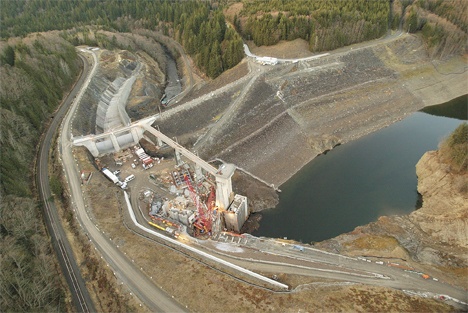Two weeks ago the U.S. Army Corps of Engineers announced that testing at Howard Hansen Dam on the upper Green River has shown things are no better than they were last January when floodwater opened two depressions on the dam’s right abutment.
Indeed, engineers say, the latest evidence points to the worrisome possibility of actual erosion in the abutment. And because the reservoir can’t hold back as much water as it historically has, the Corps again has lowered the water level.
The Corps will lay down a barrier of concrete called a grout curtain over the wall of the abutment. Whether that will solve the problem is unknown, said Corps spokeswoman Casondra Brewster.
But in any event, the curtain will not be finished until the first week of November, the start of the flood season. And that will carry obvious consequences for downstream communities like Auburn that have relied upon the protection the dam affords from flooding.
“We can expect this winter to be at the reduced capacity it is now of the dam, which may well lead us to flood,” said Sarah Miller, Auburn’s emergency preparedness manager.
Miller said that residents should brace for problems that could range from power outages to backed up sewer systems.
City officials recently released a map that depicts scattered areas that could flood depending on various factors and conditions. This map is available at City Hall and on the City’s Web site, www.auburnwa.gov by ckicking on “emergency” on the brown bar near the top of the page. The City will distribute a second map in the coming weeks that will show where the power, natural gas, sewer, storm drain and communication outages would be.
“We are telling the public that what they lose and how long they will lose it will depend on where they live and how big the storm is. And even though people may not live near the flooded areas, their houses could still be impacted, even people on the hills,” Miller said.
Of keen concern to City officials is the sewer system. The City recently hired a consultant to map out areas where the sewer system may stop working during a flood.
“One of the things we are still trying to get our hands around is that if it floods, and the storm water system is overwhelmed, and water starts filling up the sanitary sewer pipes, it doesn’t matter where you are in Auburn, on the hillside or on the flat, there’s no toilets, unless you are on septic,” said Auburn Mayor Pete Lewis.
Cities including Auburn, Pacific, and Algona have pipes that service homes and businesses, and these connect to King County’s main trunk line. The county takes the water, treats it at the Renton treatment plant and discharges it into Puget Sound.
In the case of south King County and the Green River, most wastewater flows through the pipes by gravity and very little pumping is done until the water hits the treatment plant.
There are three interceptors from Auburn, Algona and Pacific that tie into the county’s large line that runs through Kent. There are several interceptors in the Kent area and the south interceptor through Renton that ties into the line. But the plant also is connected to Snohomish County as well as the cities of Woodinville, Redmond, Bellevue, Issaquah, Newcastle and Tukwila.
Risk to sewer line
Christie True, director of King County’s wastewater treatment division, said that while flow scenarios range in severity in terms of flooding and depth, county officials assume that under many of the scenarios their line would be under water.
“What can happen in those circumstances is that the floodwater can get into the sewer system through toilets, showers, manholes with holes on them, drains or any other things that are under water,” True said. “Those become places where floodwater in addition to sewage starts filling up our sewer system. Now we have a situation where essentially we have a sewer system that can’t work as well as it should because it gets filled up with flood water. Consequently, it could actually cause sewer backups, even in areas that aren’t necessarily under flood water. … We are advising people if they are in the flood-prone areas not just to think of flood water coming in, but the potential for sewers to back up.”
True said with all that water flowing to the treatment plant, the county might have to run the plant at high flow conditions for several days.
“When you think about it, we are just going to be a big drain,” True said. “We are like a river that’s underground, and we will try to treat as much water through the plant as best we can, but our river has to catch up. If people don’t have running water, if the sewers aren’t working, if the electricity is not working, people need to think about the things they need to do under those circumstances. There may be circumstances where we ask people to curtail their use of the sewer as much as possible, even if they are not in the flood-prone areas to help drain flood waters from the valley. With respect to the sewer system, we have lots of understanding about how water gets into the system, but we have never had a situation where the system was under water so we could determine what the impact would be.”
Auburn City Councilman Rich Wagner said the odds of a flood like last winter’s happening again before the Corps fixes the abutment are remote.
Wagner said that people should prepare to be without a working toilet for two to three days.
“My recommendation is that everybody buy a five-gallon bucket, “ Wagner said.



